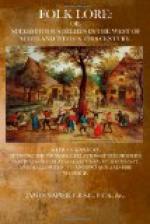At the close of the sixth century, Pope Gregory sent St. Augustine, or Austin, to this country as a missionary, and by his preaching, many thousands of the people were converted to Christianity. This Pope’s instructions to Augustine concerning his treatment of heathen festivals, were that “the heathen temples were not to be destroyed, but turned into Christian churches; that the oxen killed in sacrifice should still be killed with rejoicing, but their bodies given to the poor, and that the refreshment booths round the heathen temples should be allowed to remain as places of jollity and amusement for the people on Christian festivals, for it is impossible to cut abruptly from hard and rough minds all their old habits and customs. He who wishes to reach the highest place must rise by steps, and not by jumps.”
From the enunciation of this policy, we can readily understand how the festive observances connected with heathen worship remained in the Christian observance. I have stated what is supposed to have been the Druidical manner of keeping this festival of the winter solstice, but I have not seen any account of how the festival was observed in this country when Augustine arrived as missionary. I have no information concerning the manner in which the oxen were sacrificed, nor the character of the refreshment booths round the temples. We know that there were booths in connection with heathen temples where women were kept, but whether this practice was indigenous in Britain, or was imported into this country by the Romans, or whether Pope Gregory may have written without any special knowledge of the customs here, but merely from his knowledge of heathen customs in general, we do not know. Nothing is said in these instructions about changing the day of keeping the festival from the solstice to the 25th of December. It is probable that no change of date was made at this time, at all events we may, from the following circumstance, infer that the change, if made, did not reach the northern portion of the island. Haco, King of Norway, in the the tenth century fixed the 25th December as the day for keeping the feast of Yule. King Haco’s fixing on this particular date would be a resultant from the Romish edict, for the Norwegians were at this time Christians, although their Christianity was a conglomerate of heathen superstition and church dogma.
According to Jamieson, the eve of Yule was termed by the Northmen Hoggunott, meaning Slaughter night, probably because then the cattle for the coming feast were killed. During the feast, one of the leading toasts was called minnie, meaning the cup of remembrance, and Dr. Jamieson thinks that the popular cry which has come down to our times as Hogmany, trol-lol-lay, was originally Hogminne, thor loe loe, meaning the feast of Thor. After the Reformation, the Scotch transferred Hogmanay to the last day of December, as a preparation day for the New Year. The practice of children going from door to door in little bands, singing the following rhyme, was in vogue at the beginning of this century in country places in the West of Scotland:—




